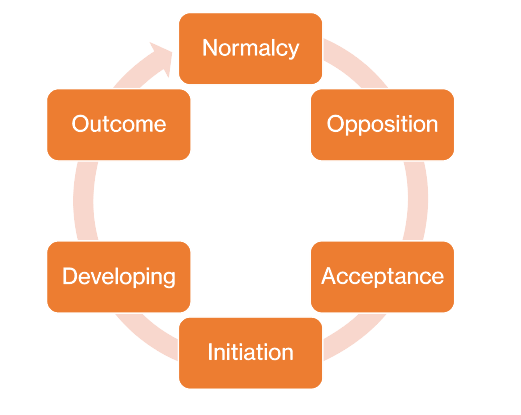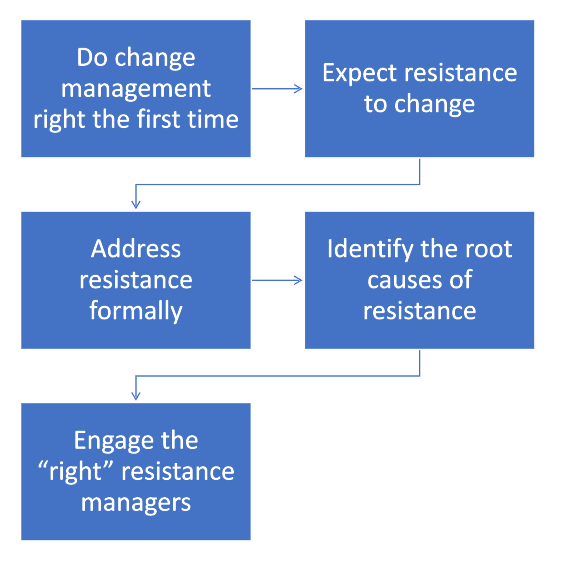Treaty 2 Territory
Change is going to happen. How we respond to this change is crucial.
Transformation and growth happen when the change that you are trying to implement becomes part of the culture of your organization. Communication and planning are critical.

People are going to respond to change differently. Everyone will be somewhere on the Continuum of Change, depicted in the diagram.
Normalcy is characterized by shock, denial, and disbelief that what is known or normal won’t be.
Opposition will manifest through anger, finger pointing, and passive aggressive commentary.
Someone in the Acceptance stage of the continuum realizes that change is going to happen. In this stage, leaders need to be empathetic and supportive of staff.
In the Initiation stage, staff begin to adapt to change; they productively participate; and realize the possibilities that are available with the change.
Developing is characterized by behavior beginning to change, new processes are integrated, and these new processes become new routines.
In the Outcome phase, those involved begin to see that change wasn’t so bad, that there was growth.
Everyone starts at some point on the continuum, they may move back and forth or cyclically through the continuum. As one process ends the continuum starts again. Some team members may start a new cycle in the middle of the current cycle, as subsequent changes happen within individual departments or with an individual’s personal role.
Resistance to change can stem from several sources:
- Employees who are highly invested in the current way of doing work
- People who created the current way of doing work that will be changed
- Employees who expect more work as a result of the change
- Those who advocated a particular alternative, (e.g., they wanted Option B, but Option A was selected)
- People who have been very successful and rewarded in the current way of doing work

As leadership works towards managing the resistance to change, it is important to keep the following points in mind:
Each person’s reaction to change is founded on their past experiences with change. These experiences bring about biases, fears, assumptions and perceptions that can have positive or negative influence on how an individual progresses through future changes.
Conversations with team members need to be:
- Leader-initiated
- Empathy-driven discussions
- Non-judgmental
As you self-reflect on your own feelings, assumptions, or reactions to change, these questions may help you move through the Continuum of Change or provide you with tools to support team members as they maneuver through change.
- Obviously, we’re going through a lot of change. How are you feeling about it? What questions does it create?
- Change often causes us to give up or lose something. What do you fear, giving up or losing?
- What about this change leaves you feeling uncertain/worried?
- What part of this change is creating an obstacle for you?
- Do you anticipate unintended consequences as a result of this change?
- What’s been your experience with other changes you’ve been through?
- How might you benefit from this change? What part of the change presents the greatest opportunity for you?
- Do you understand your role in this change?
- Do you understand what’s expected of you with this change?
- How committed are you to making this change work, on a scale from 1 to 10?
- What resources or assistance do you need to make this change work?
- Any thoughts on how this change might best be implemented or things to watch out for?
(The One-on-One Change Conversation Guide.pdf, LinkedIn Learning, Change Management Foundations – Scott Mautz)

Six questions to consider before beginning the change process.
Have you determined the problem you are trying to solve with the change?
Are all the proposed changes aligned with the problem being addressed? Are there too many changes?
Is your vision for change clear?
How will the proposed change impact current policies, process and roles/responsibilities?
Who is responsible for the change?
How will you measure success?
References
5 Tips for Managing Resistance to Change (prosci.com)
Zel, U. (2016). Leadership in change management. ResearchGate. DOI:10.4018/978-1-4666-7.ch013
The One-on-One Change Conversation Guide.pdf, LinkedIn Learning, Change Management Foundations – Scott Mautz
Valerie McInnes, B.Ed. (she/her/hers)
Zoongi Gaabawa Keetahbih Mukwa (Strong Standing Circling Bear)
Lifelong Learning Bundle Holder
Government – First Nations Treaty 2 Territory (FNT2T)
